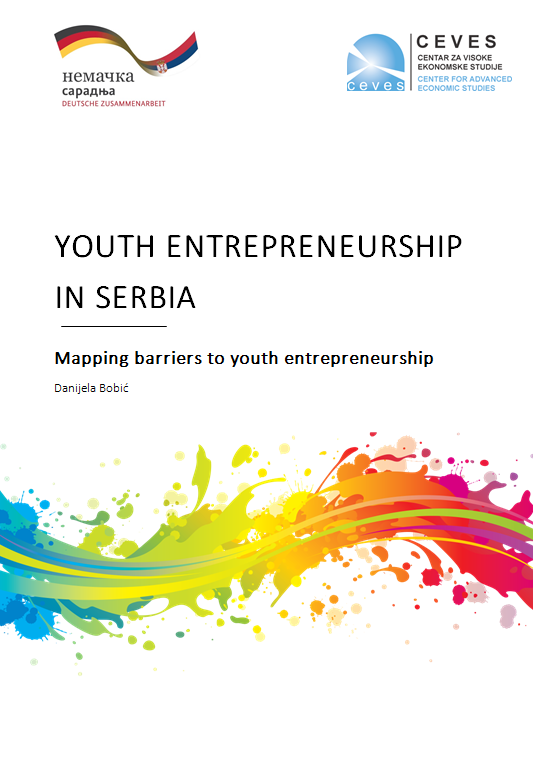Youth Entrepreneurship in Serbia
– Mapping barriers to youth entrepreneurship –
 With the brochure entitled „Youth Entrepreneurship in Serbia – Mapping barriers to youth entrepreneurship“ CEVES presents its first results of research that was conducted in previous period. Study presents institutional and legal barriers youth has to face in order to start their own businesses. Education as obvious barrier for youth activism and developing skills is not subject of this study.
With the brochure entitled „Youth Entrepreneurship in Serbia – Mapping barriers to youth entrepreneurship“ CEVES presents its first results of research that was conducted in previous period. Study presents institutional and legal barriers youth has to face in order to start their own businesses. Education as obvious barrier for youth activism and developing skills is not subject of this study.
Much like their peers worldwide, youth in Serbia are faced with numerous challenges when entering the labor market. Figures from the Serbian labor market show a dire situation for young people, since the unemployment rate of this segment of population is almost twice that of the general unemployment rate. Starting a business is one solution for those inclined towards entrepreneurship – and the percentage of such individuals among youth is 36%, higher than in the general population. However, the share of those who actually start a business is significantly lower.
Study gives overview of three particular barriers Serbian youth face: 1) Access to finance and capital; 2) Fiscal and para-fiscal system; 3) Information and practical skills. Beside these barriers which are characteristic for all those starting the business, study shows barriers affecting specific youth groups: 1) Highly skilled youth; 2) Youth in vocational education and training (VET); 3) Youth not in employment, education or training (NEET); 4) Young women; 5) Socially vulnerable youth.
Study has been done with the support of the German-Serbian Initiative for Sustainable Growth and Employment.
Mapping barriers to youth entrepreneurship
Serbia’s Real Sector Performance
Serbia must jump-start growth if it is to increase the wealth  and living standards of its citizens. However, relative to the development seen between the political transition of 2000 and the onset of the economic crisis in 2008, policymakers must strive to implement a model that is more sustainable, inclusive, and smart. Drawing on the lessons of not only Serbia’s past, but also the experience of countries similar to Serbia in terms of economic structure and geographic location, this report asserts that exports must play an integral role as the locomotive of Serbian growth. In a domestic economic environment characterized by limited and anaemic growth, Serbia must look beyond its borders to find its opportunity for development.
and living standards of its citizens. However, relative to the development seen between the political transition of 2000 and the onset of the economic crisis in 2008, policymakers must strive to implement a model that is more sustainable, inclusive, and smart. Drawing on the lessons of not only Serbia’s past, but also the experience of countries similar to Serbia in terms of economic structure and geographic location, this report asserts that exports must play an integral role as the locomotive of Serbian growth. In a domestic economic environment characterized by limited and anaemic growth, Serbia must look beyond its borders to find its opportunity for development.
The main goal of CEVES’s report “Serbia’s Real Sector Performance” is to shed light on the most promising industries, with the potential to drive sustainable growth and development of Serbia’s economy through enhanced international competitiveness and exporting activities. This research was supported and funded by USAID SLDP. The origin of this Report flowed from a basic economic policy-making question: Can we measure the potential of Serbia’s various SME sectors to competitively expand their share of world markets? An affirmative answer to this question would allow us to discern which sectors are dynamic, which sectors are stalled or waning, and how government and donor assistance could be targeted among the different sectors to increase overall economic performance and world market penetration by Serbian firms. This is an important issue because it addresses the key concern of whether Serbia’s private sector firms have the capacity to grow and help absorb the crushing unemployment present throughout the nation.
The report is divided into six chapters:
The first and second chapter discuss the current state of the Serbian economy. The third chapter more closely examines the state of Serbian exports, which collectively constitute a locomotive of economic growth, and analyse the competitiveness of industries. The fourth chapter complements the analysis of export competitiveness and enables a deeper examination of the characteristics of various industries that constitute the Serbian economy. The fifth chapter integrates the results of the previous two chapters in providing a holistic picture of the most promising and globally competitive industries within the Serbian economy. The final chapter narrows the focus on the Fabricated Metal Products industry, one of the most promising industries in Serbia’s economy.
Report – Serbia’s Real Sector Performance
Entrepreneurship in Serbia – Necessity or Opportunity?
With the brochure entitled “Entrepreneurship in Serbia – necessity or opportunity?” CEVES  presents its first results of research, aimed at advocating for developing the evidence based entrepreneurship development, raising attention of the public, policy makers, on top with entrepreneurs to the fact that entrepreneurship possess significant potential, hampered for years by lack of understanding, negligence or even distrust.
presents its first results of research, aimed at advocating for developing the evidence based entrepreneurship development, raising attention of the public, policy makers, on top with entrepreneurs to the fact that entrepreneurship possess significant potential, hampered for years by lack of understanding, negligence or even distrust.
The brochure eclectically combines some of the results of three projects, aimed at providing analytical foundation necessary for CEVES’ long-term intention to influence the promotion of Serbian entrepreneurship:
- The first project conducted in the fall of 2013, entitled „Evidence-based policy advocacy for entrepreneurship – friendly enterprise and industrial policy in Serbia“, examined attitudes of citizens and public opinion creators towards entrepreneurship and private sector. The project was supported by the European Fund for the Balkans.
- Project “The stylized facts of small business sector characteristics in Serbia: 2005-2012 ” represents a detailed analysis of available data on the corporate sector, with particular emphasis on small and medium enterprises.
- „Expanding public’s understanding and stakeholder participation in economic policy-making in Serbia“ is still in progress and deals with the analysis of the process of economic policy decision-making, by providing examples of “good and bad” practices, and by raising awareness of the importance broad stakeholders” participation in that process. The project is supported by the Balkan Trust for Democracy.
Brochure – Enterpreneurship in Serbia – A Necessity or an Opportunity?

 SR
SR